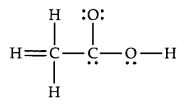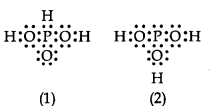

(a) Define dipole moment. What are the units of dipole moment?
(b) Dipole moment values help in predicting the shapes of covalent molecules. Explain.
(a)Dipole moment: In a polar molecule, one end bears a positive charge and the other has a negative charge. Thus, the molecule has two poles with equal magnitude of the charges. The molecule is known as dipolar molecule and possesses dipole moment.
It is defined as the product of the magnitude of the positive or negative charge and the distance between the charges. µ (dipole moment) = q x d
SI unit of dipole moment is coulomb metre (m) or Debye.
(b)The dipole moment values are quite helpful in determining the general shapes of molecules.
For molecules with zero dipole moment, shapes will be either linear or symmetrical. For Example. BeF2 CO2etc. Molecules that possess dipole moments, their shape will not be symmetrical.
Match the species in Column I with the geometry/shape in Column II.
| Column I | Column II |
| (i) H30+ | (a) Linear |
| (ii) HC = CH | (b) Angular |
| (iii) Cl0–2 | (c) Tetrahedral |
| (iv) NH+4 | (d) Trigonal bipyramidal |
| – | (e) Pyramidal |
Account for the following:
(i) Water is a liquid while H2S is a gas
(ii) NH3 has higher boiling point than PH3.
Which of the following statements are correct about CO32- ?
(a) The hybridization of central atom is sp3.
(b) Its resonance structure has one C – O single bond and two C = O double bonds.
(c) The average formal charge on each oxygen atom is 0.67 units.
(d) All C – O bond lengths are equal.
Match the shape of molecules in Column I with the type of hybridization in Column II.
| Column I | Column II |
| (i) Tetrahedral | (a) sp2 |
| (ii) Trigonal | (b) sp |
| (iii) Linear | (c) sp3 |
In which of the following substances will hydrogen bond be strongest?
(a) HCl
(b) H20
(c) HI
(d) H2S
The skeletal structure of CH3COOH as shown below is correct, but some of the bonds are shown incorrectly. Write the correct Lewis structure for acetic acid.

Using molecular orbital theory, compare the bond energy and magnetic character of 0+2 and O–2
Which hybrid orbitals are used by carbon atoms in the following molecules?
(a) CH3-CH3 (b) CH3-CH = CH2 (c) CH3-CH2-OH (d) CH3-CHO (e) CH3COOH.
Name the two conditions which must be satisfied for hydrogen bonding to take place in a molecule.
3PO3 can be represented by structures 1 and 2 shown below. Can these two structures be taken as the canonical forms of the resonance hybrid representing H3PO3? If not, give reasons for the same.

What is meant by hybridisation of atomic orbitals? Describe the shapes of sp, sp2, sp3 hybrid orbitals.
(a) How many a and n bonds are present in

(b) Why Hf is more stable than H2?
(c) Why is B2 molecule paramagnetic?
Predict the shapes of the following molecules on the basis of hybridization. BC13, ch4, co2, nh3
Draw diagrams showing the formation of a double bond and a triple bond between carbon atoms in C2 H4 and C2 H2 molecules.
Explain the diamagnetic behaviour of P2 molecule on the basis of molecular orbital theory.
Explain the non linear shape of H2S and non planar shape of PCl3 using valence shell electron pair repulsion theory.
Apart from tetrahedral geometry, another possible geometry for CH4 is square planar with the four H atoms at the comers of the square and the C atoms at its centre. Explain why CH4 is not square planar?
In N0–3 ion, the number of bond pairs and lone pairs of electrons on nitrogen atom are
(a) 2, 2 (b) 3, 1 (c) 1,3 (d) 4, 0
Why does type of overlap given in the following figure not result in the bond formation?

What is an ionic bond? With two suitable examples explain the difference between an ionic and covalent bond?
Explain why CO2-3 ion cannot be represented by a single Lewis structure. How can it be best represented?
What is meant by the term average bond enthalpy? Why there is difference in bond enthalpy of O – H bond in ethanol (C2H5OH) and water?
Match the species in Column I with the bond order in Column II.
| Column I | , . Column II |
| (i) NO | (a) 1.5 |
| (ii) CO | (b) 2.0 |
| (iii) o–2 | (c) 2.5 |
| (iv) 02 | (d) 3.0 |
Although geometries of NH3 and H20 molecules are distorted tetrahedral, bond angle in water is less than that of ammonia. Discuss.
Use Lewis symbols to show electron transfer between the following atoms to form cations and anions (a) K and S (b) Ca and O (c) Al and N.